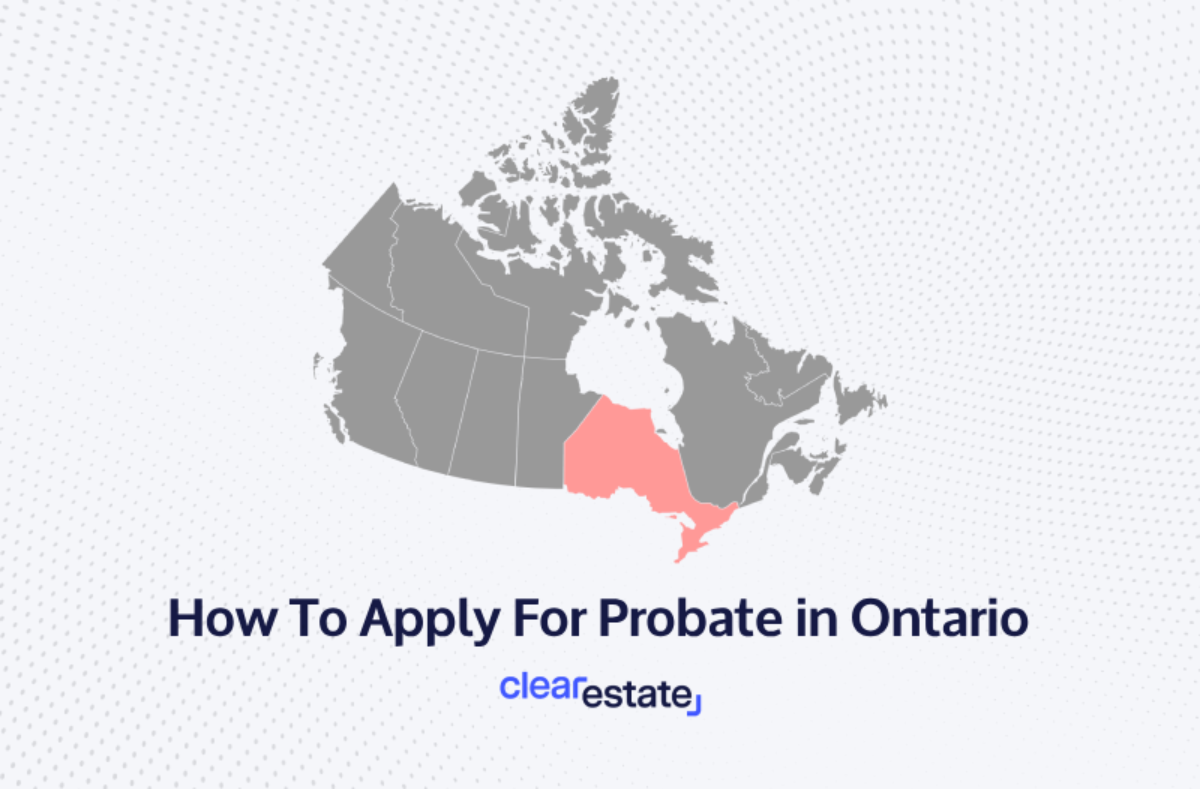Estate Settlement
Dec 04, 2024
How Do Executors Mail Inheritance Checks?
Find out how inheritance checks are mailed, including security measures and what to do if there are delays in receiving them.
Applying for probate in Ontario? Our guide covers submitting the necessary estate forms to the Superior Court and more, step-by-step.


Applying for probate in Ontario is the act of an estate trustee applying for a certificate of appointment. This document provides the estate trustee legal authority to act on behalf of the estate and carry out the wishes of the deceased.
To obtain a certificate of appointment, the estate trustee must gather all important documents and information of the deceased; such as the valid will (if it exists), death certificate, beneficiary identification, and more to successfully apply for probate.
In this guide, we will break down everything you need to know about applying for probate in Ontario.
Not just anyone can apply to be an estate trustee so this begs the question; who is authorized to apply for probate?
Well, there are mainly 2 entities that can apply for probate:
Note:
In some cases, the Office of the Public Guardian and Trustee can be appointed an administrator when no one else is willing or able to do so.
If you are one of: the named executor(s) in the will, or eligible next of kin of the deceased and intend to apply for probate - you will need to gather all important documents about the deceased.
A full probate proceeding might not even be necessary if the deceased's estate is valued at less than $150,000. In this case, an estate trustee can apply for a small estate certificate.
First things first, gather all of the pertinent documents about the deceased in relation to their estate - such as:
While these are the documents most necessary for a successful probate application, it’s not just limited to.
Which forms does someone need to apply for probate? Well, let us explain:
Following the recent streamlining of Estate court forms, with the latest changes effective April 1, 2024, the Ontario court now offers a straightforward probate application process.
To apply for probate, you will need the following forms:
These forms will require information about the deceased such as their name, date of birth, date of death, place of residence, statement of assets, etc.
If the deceased had a holographic will, the executor requires:
If the deceased passed away without a will:
While form 74H was recently amended on April 1st, 2024 - O. Reg. 388/23, s. 1 (2). Estate trustees applying for a certificate of estate trustee without a will, requires 2 forms depending on the situation:
Form 74G (Renunciation) is mandatory when there are individuals who are entitled to be appointed as estate trustees but have chosen not to apply for the role themselves. This includes:
Form 74H (Consent to the Applicant's Appointment) is required in situations where the applicant is not named as an estate trustee in the will or there is no will. It must be provided by:
If the decedent passed away without a will, the estate trustee applying for probate may require an estate administration bond, which in Ontario can be done in the form of a Personal surety or Insurance.
If a bond is needed you will need either of these forms:
As part of the probate application process, you must share a copy of your completed application form with all individuals entitled to the estate, prominently including beneficiaries.
Ensure that the document you distribute is duly signed by you in the presence of an Ontario Commissioner for Taking Affidavits, who must also authenticate it.
Methods of Distribution:
Email: Directly to the beneficiary’s most recent email address.
Mail or Courier: To the beneficiary's latest physical address, utilizing standard postal service or courier options.
Special Considerations:
In cases where the estate includes minors or adults deemed incapable of managing their affairs, the application form should also be sent to relevant legal guardians or representatives. This typically involves:
For Minors: The Office of the Children’s Lawyer.
For Incapable Adults: The Office of the Public Guardian and Trustee.
Timing: Ensure all relevant parties have received the application form before you proceed with filing your application at the court.
You can file your application for probate in two (2) ways:
For those opting to file probate documents by email, adherence to the following streamlined protocol is mandatory:
Prepare final forms for submission: Alongside the required probate forms, complete an Information Form (information form can be found here). Email these to the court, including all requisite documents such as affidavits, consents, proof of death, time of death, renunciations, draft certificates, and motions.
*** Emails to the respective Superior Court of Justice probate division, can be found here: https://www.ontariocourts.ca/scj/notices-and-orders-covid-19/consolidated-notice/email-probate/ ***
Mandatory email subject line: Craft your email's subject to clearly state the court acronym, law area, court file number (if available), and document type.
For example:
"SCJ – ESTATES – ES-1234567 – Application for Certificate of Appointment of Estate Trustee"
"SCJ – ESTATES – new file – Application for Certificate of Appointment of Estate Trustee" Attachment Guidelines:
Payment of Estate Administration Tax:
Estate administration tax otherwise known as probate fees and filing fees should be sent by mail or courier, or paid in person by cheque, or over the phone via secure credit card transaction. Issuance of Probate Certificates: Certificates will be digitally issued and sent to the applicant's email.
Corrections and additions:
If notified by court staff of necessary corrections, resend documents via email. For additional document requests, follow court staff guidance on which can be emailed and which must be physically submitted.
File at the correct court location: File your application and supporting documents at the Superior Court of Justice located in the county or district where the deceased resided at the time of death. For non-residents of Ontario, file where the deceased owned property within Ontario.
Estate Administration Tax: This tax is payable upon application submission. Acceptable payment methods include certified cheque, money order, bank draft, lawyers’ trust account cheques, and debit.
Reasonable to note: The estate administration tax is applied to estate with values of amounts in excess of $50,000. Levying a 1.5% fee on the gross estate value of over $50,000. To help you with your probate fee calculation, use our probate fee calculator:here
Submission Methods:
Mail: Send your application documents and tax payment to the designated court location.
In-Person: You may also choose to file your application directly at the court office, offering a more hands-on approach to ensure all documents are promptly received and processed.
After a successful application, an estate trustee will be appointed and granted the authority to act on behalf of the estate - This includes notifying beneficiaries and creditors, locating assets, paying debts, making distributions, paying taxes, and more to settle the estate.
The estate administration process can be broken down into 5 stages:
While probate may be a long and drawn-out process, it doesn’t have to be.
Dealing with a loved one's affairs after they've passed—like figuring out what they owned, locating real property, notifying banks, notifying estate beneficiaries, filing the estate information return, sorting out estate taxes—can make a tough time even tougher.
ClearEstate makes applying for probate, and support throughout the entire probate process easy. Book a free consultation with our estate advisors today, where one of our experienced advisors can help guide you through the probate process.
 Simplify Probate Today
Simplify Probate Today
Get expert guidance from our probate specialists who've helped 10,000+ families.
Book a free consultation today